A Review of Environmental Protection and Sustainable Development in Madagascar
Abstract
1. Introduction
2. Theoretical Background
2.1. Environment Concept
- The Stockholm Declaration of 1972, containing 26 principles, was to create a better international jurisprudence for environmental law. The protection and improvement of the environment is a problem of major importance that affects the wellbeing of people and economic development [10]. It was mentioned that pollution must not exceed the environment’s capacity to clean itself. Developing countries need assistance and reasonable prices for exports to carry out environmental management. Rational planning should resolve conflicts between the environment and development. The policy must not hamper development. It stated that a lack of progress is unacceptable (Chapter 7, paragraphs 37 and 44). This priority given to economic growth while talking about renewable resources and future generations seemed paradoxical and was set in stone early on. One of the major results of the Stockholm conference was the creation of the United Nations Environment Programme (UNEP);
- The World Charter for Nature, drawn up by IUCN and solemnly containing 24 principles, proclaimed by the United Nations General Assembly on 28 October 1982, affirms that “humanity is part of nature and that life depends on the uninterrupted functioning of natural systems which are the source of energy and nutrients” [11]. The need for measures to protect nature at all levels (national, international, individual, collective or public, and private) was identified. For that, it is vital to acquire the knowledge to maintain and enhance the ability to use natural resources in order to ensure the preservation of species and ecosystems for the benefit of present and future generations. The Charter does not solve any of the difficult problems of funding, staffing, and technical assistance necessary to coordinate economic development with conservation;
- The Declaration on Environment and Development, containing 27 principles, was adopted in Rio de Janeiro on 14 June 1992, whose preamble makes the earth “the home of humanity, thus constituting a whole marked by interdependence” and whose principle 4 emphasizes that “to achieve sustainable development, environmental protection must be an integral part of the development process and cannot be seen in isolation” [12]. It mentioned that human beings are entitled to live healthy and productive lives in harmony with nature (Principle 1). Other most important principles in this Declaration are intergenerational equity (Principle 3), precautionary principle (Principle 15), and the polluter pays principle (Principle 16). It stated that long-term economic progress is only ensured if it is linked to the protection of the environment. Therefore, nations must establish a new global partnership involving governments, their people, and the key sectors of society.
2.2. Sustainable Development
2.2.1. Origin and Concept of the SDGs
2.2.2. Madagascar’s Progress in Achieving the SDGs
3. Legal Framework of the Environmental Considerations in Madagascar
Environmental Action Plan
- The first environmental program (1991–1996) was characterized by a centralized approach to the management of the environment and natural resources: zoning of protected areas based on scientific criteria without consultation with local actors and stigmatization of agriculture as the main source of resource degradation;
- The second environmental program (1997–2002) aims to optimize the management of natural resources for human development needs. The general framework for the implementation of environmental policy in its second phase is mainly focused on the intensification of more concrete actions on the ground;
- The third environmental program (2003–2008) focuses on conserving and enhancing the size and quality of natural resources to enable sustainable economic growth and a better quality of life. The objectives of the program are the adoption by the populations of sustainable management methods for renewable natural resources and biodiversity conservation, ensuring the sustainability of the management of environmental natural resources at the national level.
4. Poverty and Environmental Degradation
5. The Strategy of Environmental Protection for Sustainable Development
5.1. Air Pollution Reduction Strategy
5.2. Water Pollution Strategy
- Development of integrated water resources management to promote cleaner, more resource-friendly, and sustainable methods of extraction and recycling of water and by establishing economic measures that support the rational use of water resources;
- Development of public–private partnerships for drinking water supply or improvement of the irrigation system.
5.3. Reducing and Managing Climate Change Risks
- Strengthening the technical capacities of stakeholders and affected entities about the climate-smart approaches to generate benefits both for mitigation and adaptation while improving livelihoods and maintaining ecosystem services;
- Monitoring and evaluation of the costs and effectiveness of the various climate-smart landscape measures to achieve adaptation, mitigation, and improved livelihoods for the scaling-up and replication of these measures in other regions;
- Ensuring that financial resources are sustained beyond the closure of the project to support climate efforts in high-value landscapes in Madagascar through capital investments in a trust fund dedicated to climate change;
- Integrating strategies and actions of national policies on climate change in the decentralized planning efforts at regional and local levels.
5.4. Green Economy
5.5. Renewable Energy Sources
5.6. Raising Public Awareness of the Environmental Issues
6. Conclusions
Author Contributions
Funding
Acknowledgments
Conflicts of Interest
References
- UNDP. Human Development Report 2016: Human Development for Everyone; United Nations Development Programme: New York, NY, USA, 2016. [Google Scholar]
- Sanbar, S. Environmental Law in Madagascar: The Nagoya Protocol on Genetic Resource Use, Access and Benefit Sharing; Independent Claremont Mckenna College: Claremont, CA, USA, 2015; Available online: https://digitalcollections.sit.edu/isp_collection/2176 (accessed on 15 July 2022).
- World Bank. Madagascar Country Environmental Analysis: Taking Stock and Moving Forward; World Bank: Washington, WA, USA, 2013; Available online: https://openknowledge.worldbank.org/handle/10986/33934 (accessed on 15 July 2022).
- Rhett, B. Madagascar. Available online: https://rainforests.mongabay.com/20madagascar.htm (accessed on 15 July 2022).
- Conolly, J. Ecotourism saves Madagascar’s rainforest and boosts living standards for locals. Boston Globe 2004, 8, 4. [Google Scholar]
- Styger, E.; Rakotondramasy, H.M.; Pfeffer, M.J.; Fernandes, E.C.; Bates, D.M. Influence of slash-and-burn farming practices on fallow succession and land degradation in the rainforest region of Madagascar. Agric. Ecosyst. Environ. 2007, 119, 257–269. [Google Scholar] [CrossRef]
- Lammers, P.L.; Richter, T.; Waeber, P.O.; Mantilla-Contreras, J. Lake Alaotra wetlands: How long can Madagascar’s most important rice and fish production region withstand the anthropogenic pressure? Madag. Conserv. Dev. 2015, 10, 116–127. [Google Scholar] [CrossRef]
- Waeber, P.O.; Wilmé, L.; Mercier, J.-R.; Camara, C.; Lowry, P.P. How effective have thirty years of internationally driven conservation and development efforts been in Madagascar? PLoS ONE 2016, 11, e0161115. [Google Scholar] [CrossRef]
- Li, N.; Pacheco-Fabig, M.; Steed, M. International Union for Conservation of Nature (IUCN). Yearb. Int. Environ. Law 2018, 29, 476–492. [Google Scholar] [CrossRef]
- Declaration, Stockholm. Declaration of the United Nations conference on the human environment. 1972. Available online: http://www.UNEP.org (accessed on 5 August 2022).
- Wood, H.W. The United Nations World Charter for Nature: The Developing Nations’ Initiative to Establish Protections for the Environment. Ecol. Law Q. 1985, 12, 977–996. [Google Scholar]
- Declaration, Rio. Report on the UN Conference on Environment and Development. In Proceedings of the UN Conference on Environment and Development, Rio de Janeiro, Brazil, 3–14 June 1992; Volume 151, p. 26.
- WCED, S.W.S. World commission on environment and development. Our Common Future 1987, 17, 1–91. [Google Scholar]
- Vieilledent, G.; Grinand, C.; Rakotomalala, F.A.; Ranaivosoa, R.; Rakotoarijaona, J.R.; Allnutt, T.F.; Achard, F. Combining Global Tree Cover Loss Data with Historical National Forest Cover Maps to Look at Six Decades of Deforestation and Forest Fragmentation in Madagascar. Biol. Conserv. 2018, 222, 189–197. [Google Scholar] [CrossRef]
- Nematchoua, M.K.; Ricciardi, P.; Orosa, J.A.; Buratti, C. A detailed study of climate change and some vulnerabilities in Indian Ocean: A case of Madagascar island. Sustain. Cities Soc. 2018, 41, 886–898. [Google Scholar] [CrossRef]
- Sachs, J.; Kroll, C.; Lafortune, G.; Fuller, G.; Woelm, F. Sustainable Development Report 2022; Cambridge University Press: Cambridge, UK, 2022. [Google Scholar]
- Hending, D.; Holderied, M.; McCabe, G.; Cotton, S. Effects of future climate change on the forests of Madagascar. Ecosphere 2022, 13, e4017. [Google Scholar] [CrossRef]
- Hoke, T.H.; Wheeler, S.B.; Lynd, K.; Green, M.S.; Razafindravony, B.H.; Rasamihajamanana, E.; Blumenthal, P.D. Community-based provision of injectable contraceptives in Madagascar:task shifting to expand access to injectable contraceptives. Health Policy Plan. 2012, 27, 52–59. [Google Scholar] [CrossRef]
- Mutua, M.K.; Wado, Y.D.; Malata, M.; Kabiru, C.W.; Akwara, E.; Melesse, D.Y.; Fall, N.A.; Coll, C.V.; Faye, C.; Barros, A.J. Wealth-related inequalities in demand for family planning satisfied among married and unmarried adolescent girls and young women in sub-Saharan Africa. Reprod. Health 2021, 18, 116. [Google Scholar] [CrossRef]
- Anthony, G.B.; Omang, T.N. Adult Literacy Education: A Pivot for Environmental Sustainability. LWATI: A J. Contemp. Res. 2019, 16, 172–193. [Google Scholar]
- Niens, J.; Richter-Beuschel, L.; Stubbe, T.C.; Bögeholz, S. Procedural Knowledge of Primary School Teachers in Madagascar for Teaching and Learning towards Land-Use- and Health-Related Sustainable Development Goals. Sustainability 2021, 13, 9036. [Google Scholar] [CrossRef]
- Reibelt, L.M.; Richter, T.; Rendigs, A.; Mantilla-Contreras, J. Malagasy conservationists and environmental educators: Life paths into conservation. Sustainability 2017, 9, 227. [Google Scholar] [CrossRef]
- Schüßler, D.; Richter, T.; Mantilla-Contreras, J. Educational approaches to encourage pro-environmental behaviors in Madagascar. Sustainability 2019, 11, 3148. [Google Scholar] [CrossRef]
- World Bank. Madagascar Country Overview, World Bank. 2022. Available online: https://www.worldbank.org/en/country/madagascar (accessed on 4 September 2022).
- Nhemachena, C.; Matchaya, G.; Nhemachena, C.R.; Karuaihe, S.; Muchara, B.; Nhlengethwa, S. Measuring baseline agriculture-related sustainable development goals index for Southern Africa. Sustainability 2018, 10, 849. [Google Scholar] [CrossRef]
- WFP. WFP Madagascar Country Brief November, WFP. 2021. Available online: https://www.wfp.org/countries/madagascar (accessed on 17 November 2022).
- IPC. Madagascar: Acute Food Insecurity April–September 2021 and Projection for October–December 2021. IPC. 2021. Available online: https://www.ipcinfo.org/ipc-country-analysis/details-map/en/c/1154855/?iso3=MDG (accessed on 17 November 2022).
- Mulligan, M.; van Soesbergen, A.; Hole, D.G.; Brooks, T.M.; Burke, S.; Hutton, J. Mapping nature’s contribution to SDG 6 and implications for other SDGs at policy relevant scales. Remote Sens. Environ. 2020, 239, 111671. [Google Scholar] [CrossRef]
- Harifidy, R.Z.; Hiroshi, I. Analysis of River Basin Management in Madagascar and Lessons Learned from Japan. Water 2022, 14, 449. [Google Scholar] [CrossRef]
- Randrianandrasana, I. The protection of the environment in the Constitution of Madagascar. Rev. Jurid. De Lenvironnement 2016, 41, 122–139. [Google Scholar] [CrossRef]
- Ministere de l’Environnement, des Eaux et Forêts. Mise en Compatibilité des Investissements Avec l’Environnement (DecretMECIE), Journal Officiel n° 2648 du 10 Juillet 2000 Et n° 2904 Du 24 Mai 2004. Available online: https://edbm.mg/wp-content/uploads/2017/12/Decret_MECIE.pdf (accessed on 8 August 2022).
- Randimby, B.; Razafintsalama, N.; Andriamampianina, L.; Reed, E.; Raheliarisoa, S.; Andriamahenina, F.; Andrianavalomanampy, T.; Andriamalala, H. An inventory of initiatives/activities and legislation pertaining to ecosystem service payment schemes (PES) in Madagascar. Wash. DC For. Trends. Retrieved Dec. 2006, 20, 2007. [Google Scholar]
- Rakotomalala, F.T.C.; Ramambazafy, R.N.J.M.; Rakotondramanana, A.L.H.; Andrianarizaka, M.T. Importance of sustainable development culture in the practice of sustainable development in Malagasy PMEs. Int. J. Appl. Sci. Eng. Rev. (IJASER) 2022, 3, 70–87. [Google Scholar]
- ONE. Loi n° 2015-003 portant Charte de l’Environnement Malagasy actualisée. Available online: https://www.pnae.mg/docs/ee/textes/loi-2015-003-charte-environnement-malagasy.pdf (accessed on 9 September 2022).
- Greve, A.M.; Lampietti, J.; Falloux, F. National environmental action plans in Sub-Saharan Africa. World Bank Work. Pap. Ser. 1995, 20973, 1. [Google Scholar]
- Voahangy Ramaromisa. The Situation of the Main Indicators Environmental in Madagascar; IIED: London, UK, 2007. [Google Scholar]
- Freudenberger, K.S. Paradise Lost? Lessons from 25 Years of Environmental Programs in Madagascar; USAID: Washington, WA, USA, 2010. [Google Scholar]
- Wolf, M.J.; Emerson, J.W.; Esty, D.C.; de Sherbinin, A.; Wendling, Z.A. Environmental Performance Index. New Haven, CT: Yale Center for Environmental Law & Policy. 2022. Available online: https://www.epi.yale.edu (accessed on 17 November 2022).
- Wunder, S. Poverty alleviation and tropical forests—what scope for synergies? World Dev. 2001, 29, 1817–1833. [Google Scholar] [CrossRef]
- Agabi, J.A. Biodiversity Loss in Nigerian Environment; Macmillan: Lagos, Nigeria, 1995. [Google Scholar]
- Abang, S.O. The Nigerian Environment and Social—Economic Pressure; Macmillan Nigeria for Nigerian Conservation Foundation: Lagos, Nigeria, 1995. [Google Scholar]
- Omotor, D.G. Environmental Problems and Sustainable Development in Nigeria. J. Dev. Stud. 2000, 2, 146–149. [Google Scholar]
- DFID. Poverty and the Environment: “What the Poor Say. Environment Policy”; Key sheet No. 1; DFID: London, UK, 2001. [Google Scholar]
- DFID. Making Connections. Infrastructure for Poverty Reduction; DFID: London, UK, 2002. [Google Scholar]
- Broad, R. The poor and the environment: Friends or foes? World Dev. 1994, 22, 811–822. [Google Scholar] [CrossRef]
- Reardon, T.; Vosti, S.A. Links between rural poverty and the environment in developing countries: Asset categories and investment poverty. World Dev. 1995, 23, 1495–1506. [Google Scholar] [CrossRef]
- Durning, A.B. Poverty and the Environment: Reversing the Downward Spiral; Worldwatch Paper 92; Worldwatch Institute: Washington, WA, USA, 1989. [Google Scholar]
- Cleaver, K.M.; Schreiber, G.A. Reversing the Spiral: The Population, Agriculture, and Environment Nexus in Sub-Saharan Africa; WorldBank: Washington, WA, USA, 1994. [Google Scholar]
- Ekbom, A.; Boĵ, J. Poverty and Environment: Evidence of Links a Integration in the Country Assistance Strategy Process; Discussion Paper No. 4; World Bank Africa Region: Washington, WA, USA, 1999. [Google Scholar]
- Mittal, I.; Gupta, R.K. Natural resources depletion and economic growth in present era. SOCH-Mastnath. J. Sci. Technol. 2015, 10, 3. [Google Scholar]
- Metz, J.J. A Reassessment of the Causes and Severity of Nepal’s Environmental Crisis. World Dev. 1991, 19, 805–820. [Google Scholar] [CrossRef]
- Jodha, N.S. Poverty-Environmental Resource Degradation Links: Questioning the Basic Premises; International Center for Integrated Mountain Development: Lalitpur, Nepal, 1998. [Google Scholar]
- Somanathan, E. Deforestation, property rights and incentives in central Himalayas. Econ. Polit. Weekly 1991, 26, 37–46. [Google Scholar]
- Jenkins, R.K.B.; Keane, A.; Rakotoarivelo, A.R.; Rakotomboavonjy, V.; Randrianandrianina, F.H.; Razafimanahaka, H.J.; Ralaiarimalala, S.R.; Jones, J.P.G. Analysis of patterns of bushmeat consumption reveals extensive exploitation of protected species in eastern Madagascar. PLoS ONE 2011, 6, e27570. [Google Scholar] [CrossRef] [PubMed]
- Golden, C.D.; Fernald, L.C.H.; Brashares, J.S.; Rasolofoniaina, B.J.R.; Kremen, C. Benefits of wildlife consumption to child nutrition in a biodiversity hotspot. Proc. Natl. Acad. Sci. USA 2011, 108, 19653–19656. [Google Scholar] [CrossRef] [PubMed]
- Randriamalala, H.; Liu, Z. Rosewood of Madagascar: Between democracy and conservation. Madag. Conserv. Dev. 2010, 5. [Google Scholar] [CrossRef]
- Wilmé, L.; Innes, J.L.; Schuurman, D.; Ramamonjisoa, B.; Langrand, M. The elephant in the room: Madagascar’s rosewood stocks and stockpiles. Conserv. Letters. 2020, 13, e12714. [Google Scholar] [CrossRef]
- UNDESA. How Accurate Are the United Nations World Population Projections? Popul. Dev. Rev. 2019, 24, 15. [Google Scholar] [CrossRef]
- Wada, Y.; Flörke, M.; Hanasaki, N.; Eisner, S.; Fischer, G.; Tramberend, S.; Satoh, Y.; Van Vliet, M.T.H.; Yillia, P.; Ringler, C.J.G.M.D.; et al. Modeling global water use for the 21st century: The Water Futures and Solutions (WFaS) initiative and its approaches. Geosci. Model Dev. 2016, 9, 175–222. [Google Scholar] [CrossRef]
- United Nations Children’s Fund (UNICEF) and World Health Organization (WHO). Progress on Drinking Water, Sanitation, and Hygiene in Schools: 2000–2021 Data Update; United Nations Children’s Fund (UNICEF) and World Health Organization (WHO): New York, NY, USA, 2022. [Google Scholar]
- Chowdhary, P.; Bharagava, R.N.; Mishra, S.; Khan, N. Role of Industries in Water Scarcity and Its Adverse Effects on Environment and Human Health. In Environmental Concerns and Sustainable Development; Springer: Singapore, 2020; pp. 235–256. [Google Scholar]
- Hanjra, M.A.; Qureshi, M.E. Global water crisis and future food security in an era of climate change. Food Policy 2010, 3, 365–377. [Google Scholar] [CrossRef]
- Transparency International. Corruption Perceptions Index. 2017. Available online: www.transparency.org/news/feature/corruption_perceptions_index_2017#table (accessed on 16 September 2022).
- Vieilledent, G.; Nourtier, M.; Grinand, C.; Pedrono, M.; Clausen, A.; Rabetrano, T.; Rakotoarijaona, J.R.; Rakotoarivelo, B.; Rakotomalala, F.A.; Rakotomalala, L.; et al. It’s not just poverty: Unregulated global market and bad governance explain unceasing deforestation in Western Madagascar. BioRxiv 2020. [Google Scholar] [CrossRef]
- Razafindratsima, O.H.; Kamoto, J.F.; Sills, E.O.; Mutta, D.N.; Song, C.; Kabwe, G.; Castle, S.E.; Kristjanson, P.M.; Ryan, C.M.; Brockhaus, M.; et al. Reviewing the evidence on the roles of forests and tree-based systems in poverty dynamics. For. Policy Econ. 2021, 131, 102576. [Google Scholar] [CrossRef]
- Scales, I.R. The Drivers of Deforestation and the Complexity of Land Use in Madagascar. In Conservation and Environmental Management in Madagascar; Scales, I.R., Ed.; Routledge: Abingdon, UK, 2014; pp. 05–126. [Google Scholar]
- Pedroso, J.R.; Murrieta, R.S.S.; Adams, C. A agricultura de corte e queima: Um sistema em transformação. Boletim do Museu Paraense Emílio Goeldi, Ciências Humanas. Belém 2008, 3, 153–174. [Google Scholar] [CrossRef]
- Brinkmann, K.; Noromiarilanto, F.; Ratovonamana, R.Y.; Buekert, A. Deforestation processes in South-Western Madagascar over the past 40 years: What can we learn from settlement characteristics? Agric. Ecosyst. Environ. 2014, 195, 231–243. [Google Scholar] [CrossRef]
- Delač, D.; Kisić, I.; Zgorelec, Ž.; Perčin, A.; Pereira, P. Slash-pile burning impacts on the quality of runoff waters in a Mediterranean environment (Croatia). Catena 2022, 218, 106559. [Google Scholar] [CrossRef]
- Wang, G.; Zhu, T.; Zhou, J.; Yu, Y.; Petropoulos, E.; Müller, C. Slash-and-burn in karst regions lowers soil gross nitrogen (N) transformation rates and N-turnover. Geoderma 2022, 425, 116084. [Google Scholar] [CrossRef]
- Frappier-Brinton, T.; Lehman, S.M. The burning island: Spatiotemporal patterns of fire occurrence in Madagascar. PLoS ONE 2022, 17, e0263313. [Google Scholar] [CrossRef] [PubMed]
- Eklund, J.; Jones, J.P.; Räsänen, M.; Geldmann, J.; Jokinen, A.P.; Pellegrini, A.; Rakotobe, D.; Rakotonarivo, O.S.; Toivonen, T.; Balmford, A. Elevated fires during COVID-19 lockdown and the vulnerability of protected areas. Nat. Sustain. 2022, 5, 603–609. [Google Scholar] [CrossRef]
- Jones, J.P.; Rakotonarivo, O.S.; Razafimanahaka, J.H. Forest conservation in Madagascar: Past, Present, and Future. In The New Natural History of Madagascar; Princeton University Press: Princeton, NJ, USA, 2021. [Google Scholar]
- Madagascar; World Bank; USAID; Cooperation Suisse; UNESCO; UNDP; World Wildlife Fund. Madagascar—Environmental Action Plan, (French); World Bank Group: Washington, WA, USA, 2010; Volume 2, Available online: http://documents.worldbank.org/curated/en/344971468756961739/Madagascar-Environmental-action-plan (accessed on 26 September 2022).
- Ministry of the Environment. The green and blue economy in Madagascar. 2021. Available online: https://www.environnement.mg/thematique-rubrique/economie-verte/ (accessed on 17 August 2022).
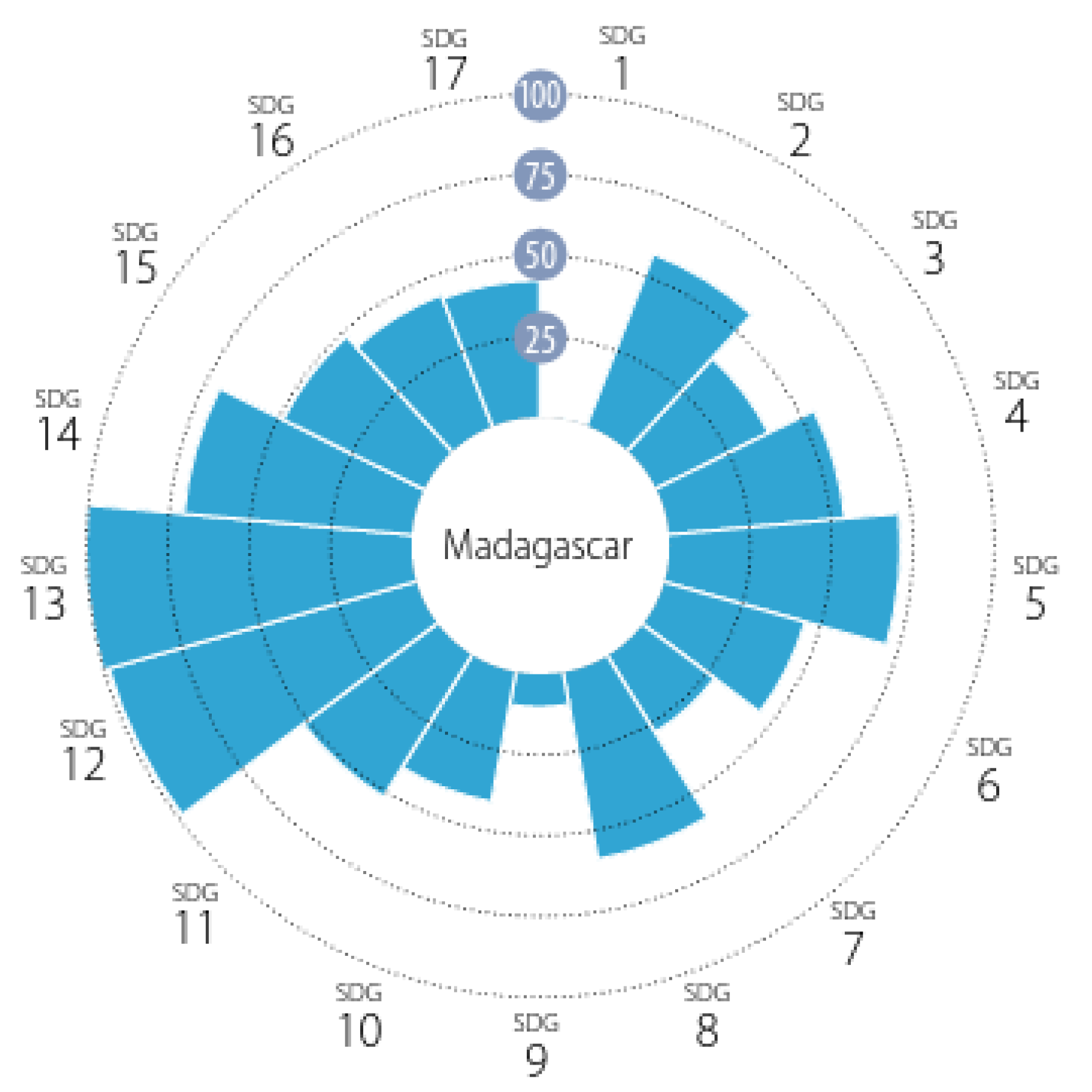

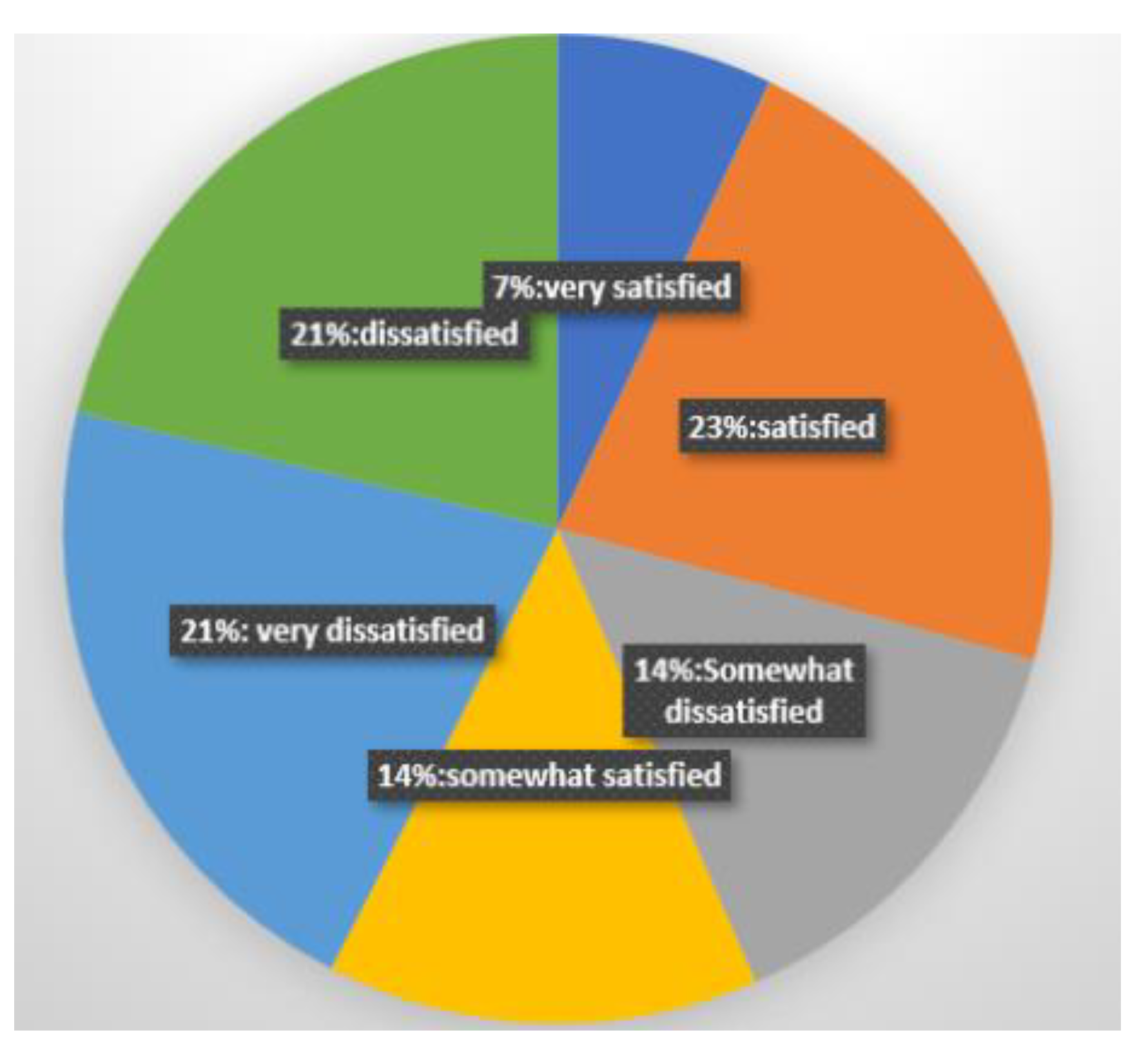
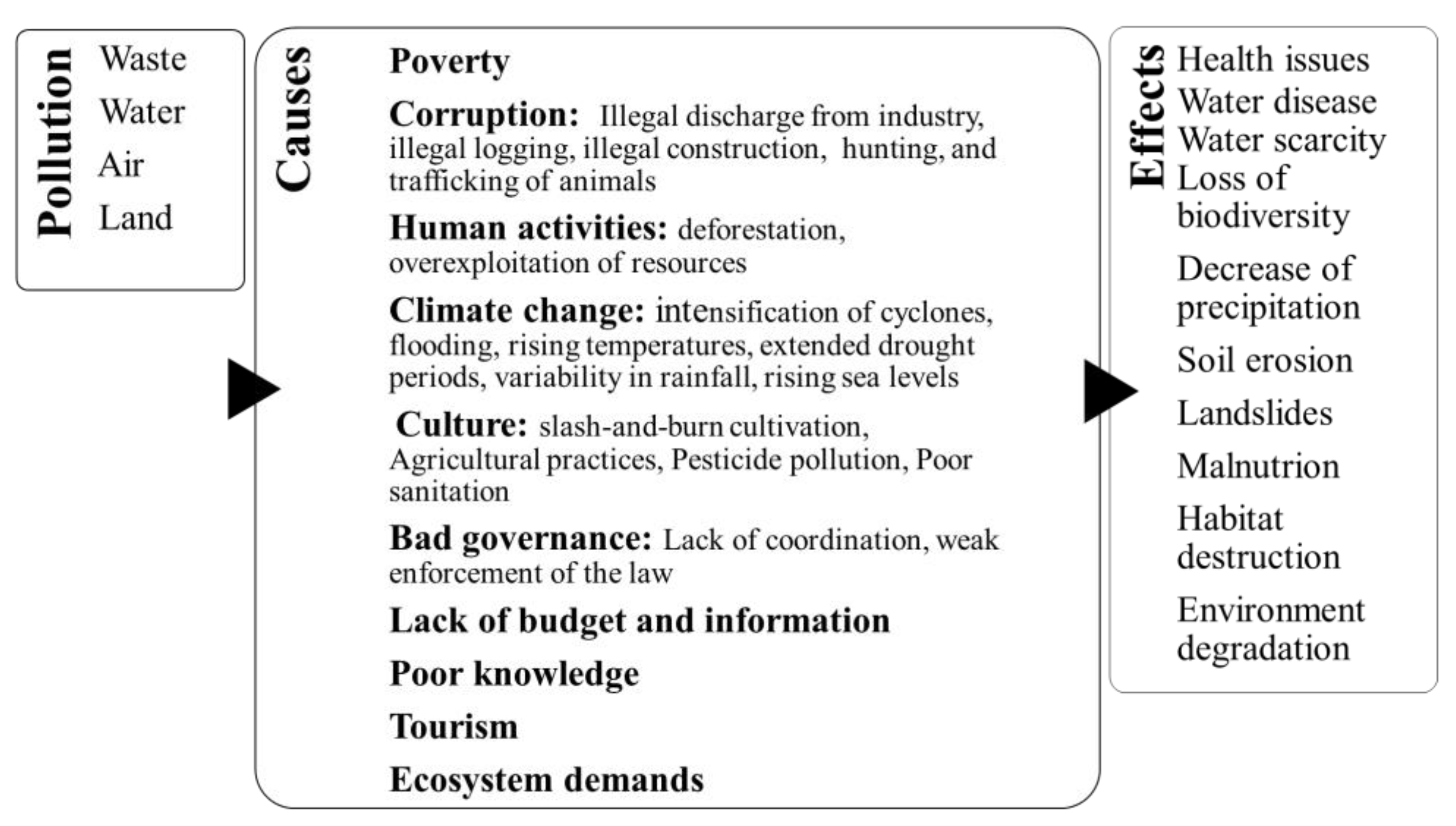
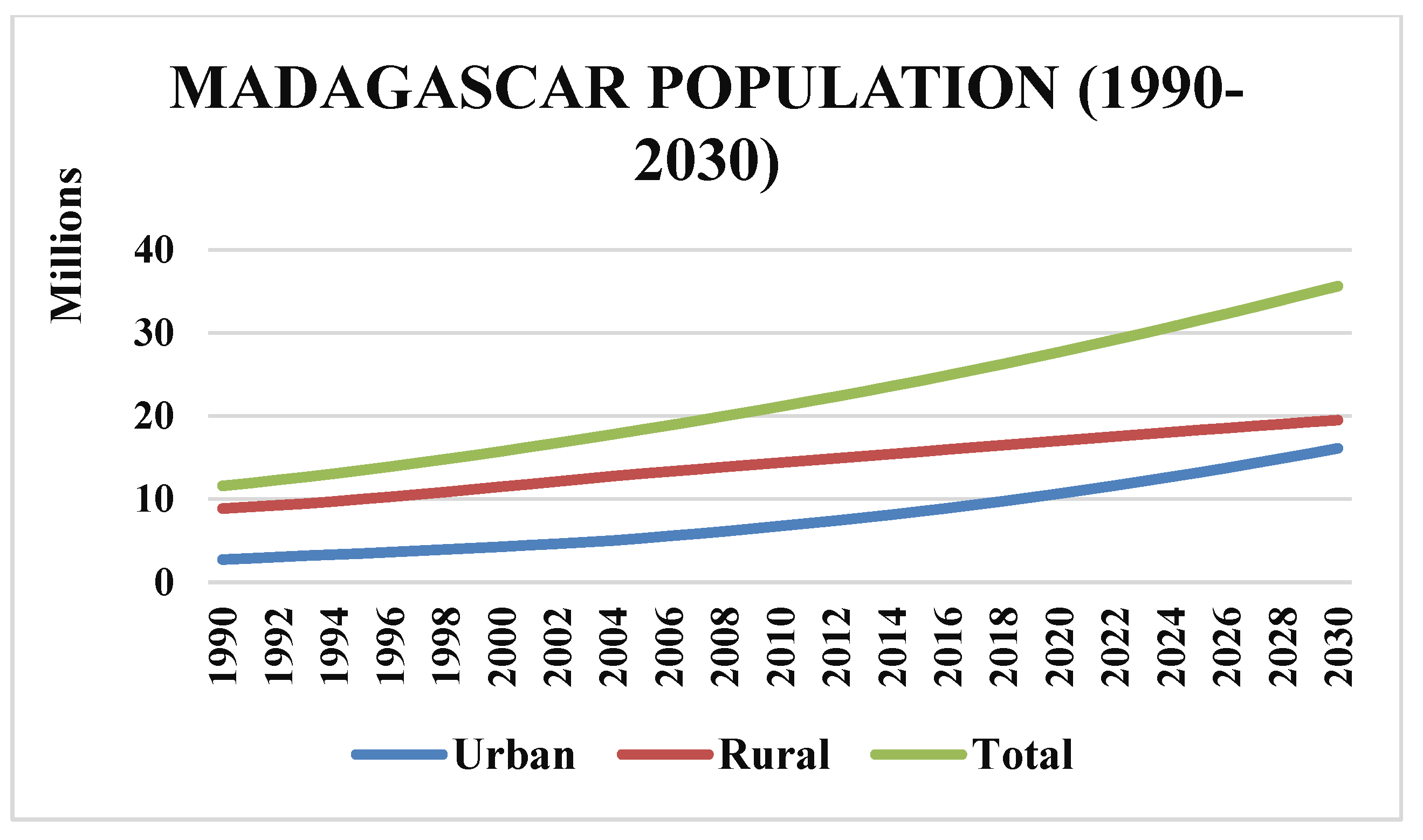
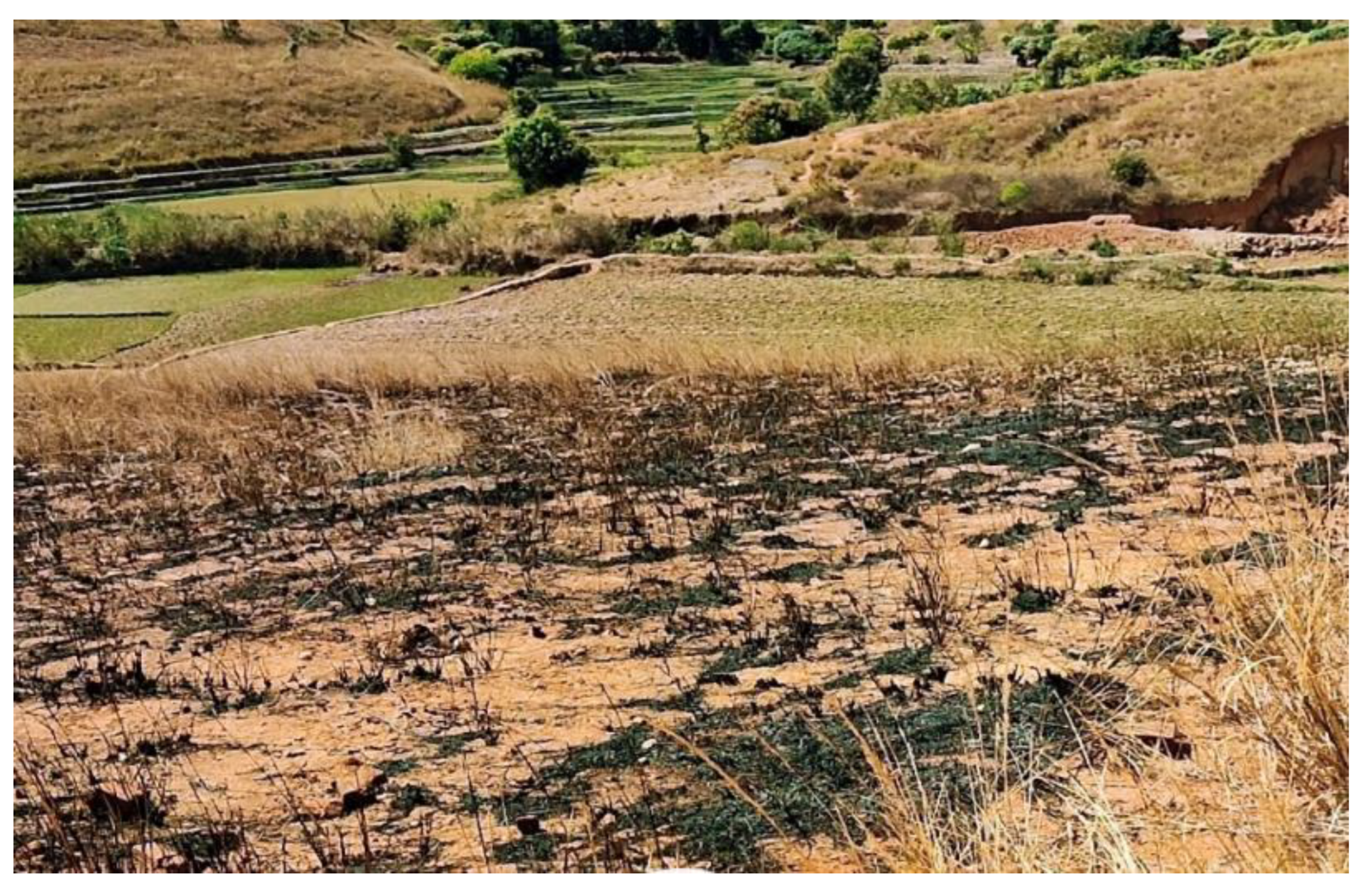
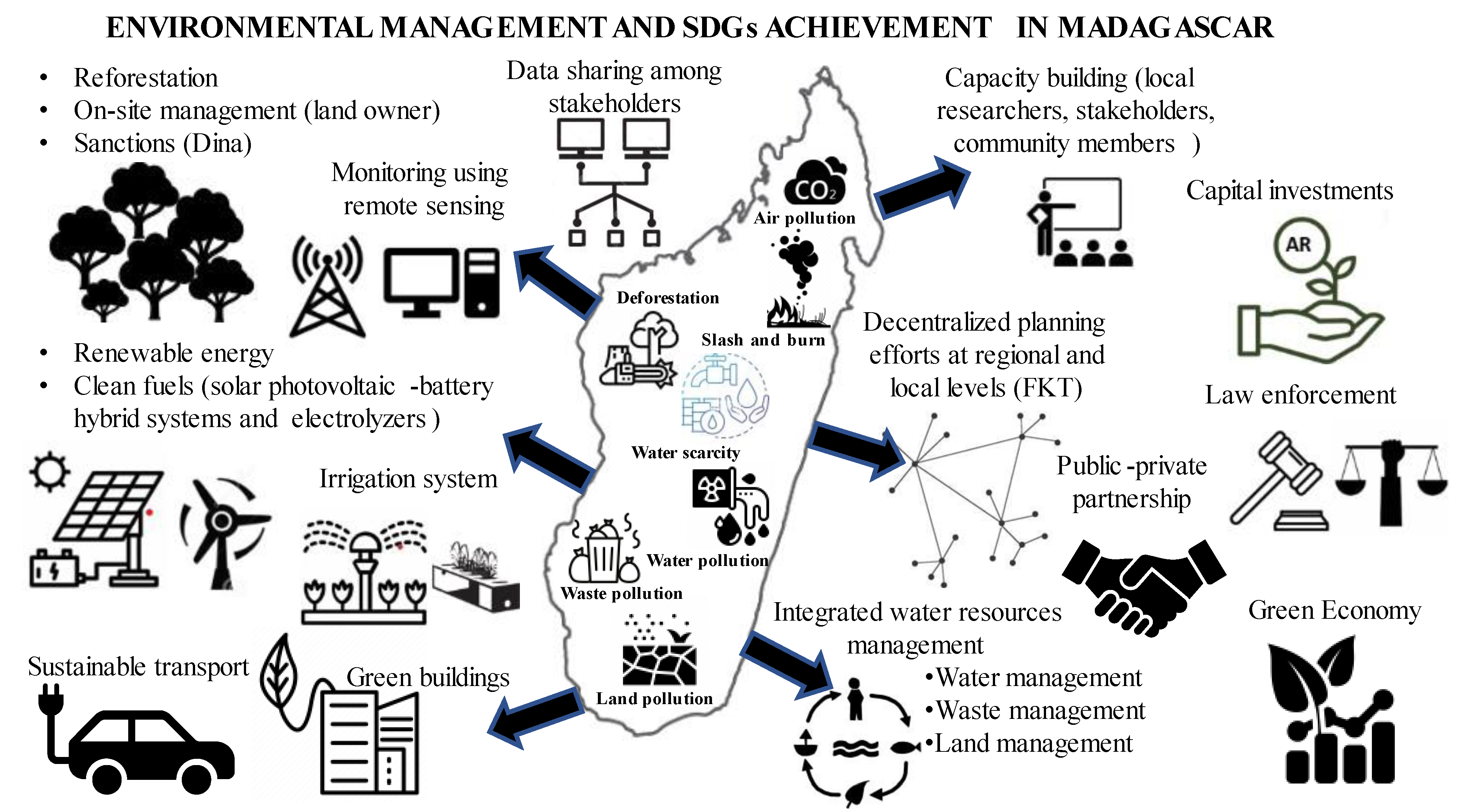
| Jiro sy Rano Malagasy | 2017 | 2018 | 2019 | 2020 |
|---|---|---|---|---|
| 1.1—Water Coverage (%) | 55.96% | 54.78% | 54.37% | 53.84% |
| 11.1—Unit Operational Cost Water and Wastewater (USD/m3 sold) | 0.43 | 0.47 | 0.54 | 0.48 |
| 12.3—Staff Water/000 Water pop served (#/000 W pop served) | 0.28 | 0.28 | 0.27 | 0.26 |
| 18.1—Average Revenue W&WW (USD/m3 water sold) | 0.32 | 0.3 | 0.28 | 0.26 |
| 23.1—Collection Period (days) | 473.13 | 430.38 | 544.65 | 691.34 |
| 23.2—Collection ratio (%) | 98.59% | 89.49% | 93.81% | |
| 24.1—Operating Cost Coverage (ratio) | 0.75 | 0.64 | 0.52 | 0.55 |
| 4.1—Total Water Consumption (liters/person/day) | 57.82 | 59.74 | 60.68 | 57.79 |
| 4.7—Residential Consumption (liters/person/day) | 46.25 | 48.47 | 49.5 | 47.76 |
| 6.1—Non-Revenue Water (%) | 40.56% | 41.63% | 40.42% | 43.92% |
| 6.2—Non-Revenue Water (m3/km/day) | 46.14 | 49.61 | 47.26 | 51.98 |
| 8.1—Water sold that is metered % (%) | 0.00% | 0.00% | 0.00% | 0.00% |
| No. | Law (Order, Decree, Act) Number | Brief Description |
|---|---|---|
| 1 | Law No. 98-029 of 20/01/1999 | Water utilization and effluent regulation |
| 2 | Law No. 99-021 of 19/08/1999 | Pollution control and policy |
| 3 | Order No. 18177/04 of 27/09/2004 | Sensitive areas in the forest |
| 4 | Order No. 4355/97 of 13/05/1997 | Environmental sensitive areas |
| 5 | Ordinance No. 93-022 of 04/05/1993 | Regulations on fishery and fish culture |
| 6 | Law No. 95-017 of 25/08/1995 | Regulations on tourism |
| 7 | Decree No. 96-1293 of 30/12/1996 | Establishment and management of tourism areas |
| 8 | Law No. 98-026 of 20/01/1999 | Road |
| 9 | Law No. 00-022 of 19/08/1999 | Mining |
| 10 | Decree No. 2000-170 of 18/11/2000 | Mining |
| 11 | Inter-ministerial Order No. 12032/2000 of 06/11/2000 | Mining |
| 12 | Decree No. 2012-430 | Environmental and social protection for mining |
| 13 | Act No. 2003-010 | Bureau National de Gestion des Risques et des Catastrophes: BNGRC |
| 14 | Act No. 2011-002 | Sanitation code |
| 15 | Act No. 98-029 | Water code |
| 16 | Act No. 2003-044 of 28/07/2004 | Labor code |
| 17 | Decree No. 2003/464 of 15/04/03 | Effluent standard |
| 18 | Law No. 96-025 of 30/09/1996 | Natural resources |
| 19 | Law No. 2005-018 of 17/10/ 2005 on the International Trade in Endangered Species of Wild Fauna and Flora (CITES) | Law regarding CITES |
| 20 | Ordinance No. 60-127 of 3/10/1960 Ordinances No. 62-127 of 1/10/1962and No. 75-128 of 22/10/ 1975 | Prevention of wildfire |
| 21 | Law No. 2001-005 11/02/ 2003 | Protected areas |
| 22 | Ordinance: No. 82-029 of 06/11/1982 | Protection of national monuments |
| 23 | Law No. 2005-006 of 14/07/2005 | Policy on culture |
| 24 | Law No. 2015-003 of 20 January 2015 | Environmental Charter (update) |
| 25 | Decree No. 99-954 of 15 December 1999, amended by Decree No. 2004-167 of 3 February 2004 | Compatibility of investments with the environment |
| International Environmental Agreements | Year Entered into Force |
|---|---|
| Convention on Fishing and Conservation of Living Resources of the High Seas Vienna | 1966 |
| Conservation of Wetlands of International Importance (Ramsar Convention) | 1975 |
| Conservation on the International Trade in Endangered Species of Wild Flora and Fauna (CITES) | 1975 |
| Convention for the Protection of the Ozone Layer | 1988 |
| Montreal Protocol on Substances that Deplete the Ozone Layer | 1989 |
| Basel Convention on the Control of Transboundary Movements of Hazardous Waste and their Disposal (Decree No. 99-141 of 22 February 1999) | 1992 |
| Convention on Biological Diversity | 1993 |
| United Nations Convention on the Law of the Sea | 1994 |
| United Nations Framework Convention on Climate Change (UNFCCC) | 1994 |
| United Nations Convention to Combat Desertification | 1996 |
| Kyoto Protocol to the UNFCCC | 2005 |
| Environmental Challenges | Implications for Poor Households | Importance of Poverty Reduction Efforts |
|---|---|---|
| Terrestrial and coastal marine degradation | The links between poverty and terrestrial ecosystem degradation in Madagascar are complex and not fully understood; it is thought that, on the one hand, poverty is a driver of degradation and that, on the other hand, the effects of this degradation are most strongly felt by poor households. Data indicate that areas with high forest cover have low population densities but high poverty rates. Data also indicate that deforestation is negatively correlated with wealth and areas of greater inequality in income distribution. Non-costed ecosystem services provided by forests, including water supply, timber, and non-timber forest products, are arguably more important to poor households. Coastal and marine resources are often a fallback in times of failure of agriculture production for households that have no alternative sources of income, either through supplementation of diets with fish products or permanent migration to coastal areas and change in livelihood strategies. In the same manner, protected areas are likely to impose higher opportunity costs on poor households as they are less able to support the restriction of access to natural resources. | High |
| Urban pollution | The predominant effects of urban air and water pollution are on public health. Poor households are more susceptible to the effects of urban pollution due to their limited access to preventive or curative health services, their often-limited knowledge on matters of sanitation and disease control, their concentration in zones where pollution rates are higher, and clean water and sanitation delivery rates are lower, and their limited economic ability to choose alternative “clean” products or services (e.g., to replace polluting indoor fuels with clean alternatives). | High |
| Industrial pollution | To date, in Madagascar, industrial pollution is less widespread than other types of environmental problems and results from small-scale unregulated industries in the main urban centers and a small number of mining mega-projects. As for urban pollution, the vulnerability of poor households to the health effects of industrial pollution is likely to be higher than for other income groups, and equally, their ability to lodge complaints or protest against industrial pollution events is more limited. | Medium |
| Natural disasters and climate change | The degree of vulnerability of a household to natural disasters or climate change is a function of exposure, sensitivity, and resilience. Poverty is thus a key factor in determining the level of vulnerability as it affects all components of vulnerability Exposure of poor households is often the highest as they are located in the most geographically exposed locations. Sensitivity is also typically higher due to the type of housing or the health of household members, as is the resilience or ability of that household to recover from a shock due to the availability of food reserves, access to credit, access to health services, etc. The effects of natural disasters and climate change are thus more felt by poor households. | High |
| Priority Challenges | Proposed Solutions |
|---|---|
| Pollution management | Increased sharing of responsibilities for environmental management and effective institutional organization |
| Deforestation eradication | Improved application of legal framework establishment of incentive schemes for environmental protection initiatives |
| Soil erosion management | Development of sustainable financing mechanisms |
| Natural resource management and biodiversity protection | Improved information, education, and communication at the national level |
| Fire management | Strengthened actions for prevention and surveillance |
| Implementation of international conventions Climate change responses | Increased efforts in control and inspection |
| Environment awareness and mainstreaming public–public and public–private partnership development | Improved mechanisms for control and inspection of environmental impacts of developments |
| Strengthened responsibility for environmental management at national and sub-national levels | Increased sharing of responsibilities for environmental management and effective institutional organization |
Publisher’s Note: MDPI stays neutral with regard to jurisdictional claims in published maps and institutional affiliations. |
© 2022 by the authors. Licensee MDPI, Basel, Switzerland. This article is an open access article distributed under the terms and conditions of the Creative Commons Attribution (CC BY) license (https://creativecommons.org/licenses/by/4.0/).
Share and Cite
Harivelo, R.Z.M.; Harifidy, R.Z. A Review of Environmental Protection and Sustainable Development in Madagascar. J 2022, 5, 512-531. https://doi.org/10.3390/j5040035
Harivelo RZM, Harifidy RZ. A Review of Environmental Protection and Sustainable Development in Madagascar. J. 2022; 5(4):512-531. https://doi.org/10.3390/j5040035
Chicago/Turabian StyleHarivelo, Rakotoarimanana Zy Misa, and Rakotoarimanana Zy Harifidy. 2022. "A Review of Environmental Protection and Sustainable Development in Madagascar" J 5, no. 4: 512-531. https://doi.org/10.3390/j5040035
APA StyleHarivelo, R. Z. M., & Harifidy, R. Z. (2022). A Review of Environmental Protection and Sustainable Development in Madagascar. J, 5(4), 512-531. https://doi.org/10.3390/j5040035






